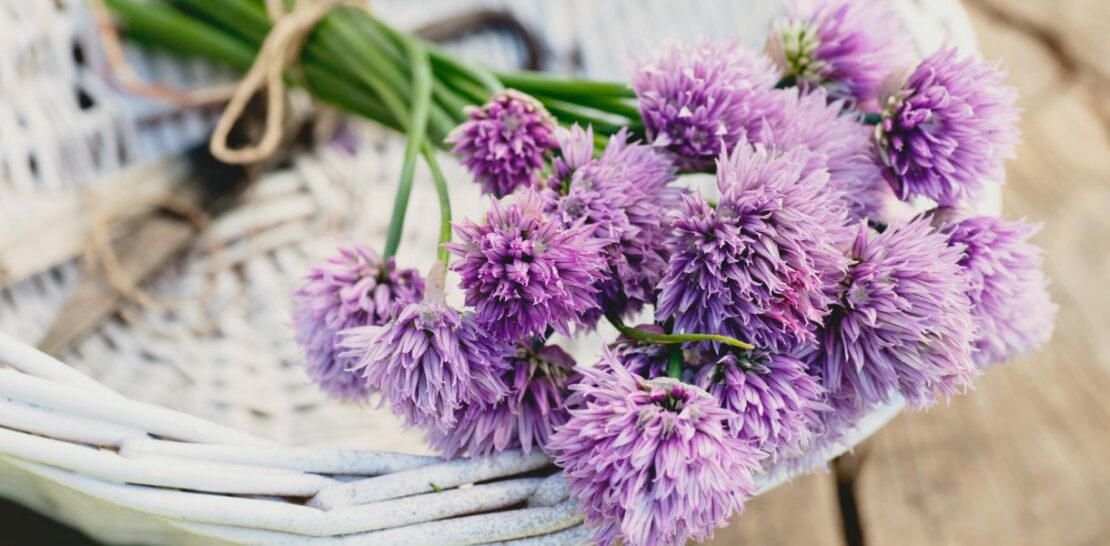When it comes to entertaining guests and making a lasting impression, there’s nothing quite like incorporating unique, seasonal ingredients into your dishes.
One such ingredient that is often overlooked but can add a touch of sophistication and intrigue to any meal is the chive flower.
In this article, we will delve deep into the world of chive flowers, exploring the various ways to cook and present them so that your guests are not only impressed, but also begging for seconds.
Understanding and Harvesting Chive Flowers
Before we dive into the many ways to cook chive flowers, it’s crucial to understand what they are and how to harvest them properly.
Chive flowers (Allium schoenoprasum) are the edible blossoms that grow atop chive plants. They are typically a vibrant purple color and have a delicate, onion-like flavor that is more subtle than the chive’s green stems. Chive flowers generally bloom in late spring and early summer, making them a perfect addition to your seasonal culinary repertoire.
When it comes to harvesting chive flowers, timing is everything. To ensure that you’re using the freshest, most flavorful blossoms, follow these steps:
- Wait until the chive plant is in full bloom, with the flowers fully opened and petals still vibrant in color.
- Use a pair of clean scissors or gardening shears to snip the flower stem about an inch below the flower head.
- Place the freshly cut blossoms in a bowl of cold water to keep them fresh until you’re ready to use them.
Now that you’re well-versed in chive flower harvesting, it’s time to explore the exciting world of chive flower recipes!
Preparing Chive Flowers: Techniques and Tips
One of the most important aspects of cooking with chive flowers is knowing how to prepare them correctly. Here are some helpful tips and techniques to ensure that your chive flowers are ready to impress:
- Removing the individual petals: Gently separate the individual petals from the flower head, discarding the central stem. This will not only make your dishes more visually appealing but also ensure a more even distribution of flavor.
- Rinsing and drying: Rinse the petals thoroughly in cold water to remove any dirt or debris, then pat them dry with a paper towel. Be gentle when handling the delicate petals, as they can easily become damaged.
- Storing chive flowers: If you’re not planning to use your freshly harvested chive flowers right away, they can be stored in the refrigerator for up to three days. Place the flowers in a sealed plastic bag or container with a damp paper towel to keep them fresh.
With your chive flowers prepped and ready to go, let’s move on to some delectable recipes that are sure to wow your guests!
Recipe Ideas for Cooking with Chive Flowers
The beauty of chive flowers lies in their versatility. Their subtle flavor and eye-catching color make them a fantastic addition to a wide range of dishes. Here are four must-try recipes that showcase the culinary potential of chive flowers:
1. Chive Flower Frittata: A classic frittata becomes a show-stopping brunch dish when you add chive flowers to the mix. Whisk together eggs, milk, salt, and pepper, then pour the mixture into a greased oven-proof skillet. Sprinkle in a generous helping of chive flower petals and cook the frittata on the stovetop until the edges are set. Finish by baking the frittata in the oven until cooked through and golden on top. Garnish with additional chive flower petals for an elegant touch.
2. Chive Flower Infused Vinegar: Chive flowers can also be used to create a flavorful and visually stunning infused vinegar. Fill a clean glass jar with chive flower petals and pour in white wine or champagne vinegar until the flowers are fully submerged. Seal the jar and store it in a cool, dark place for two weeks, then strain out the petals. Use your chive flower infused vinegar in salad dressings, marinades, or as a finishing touch on grilled vegetables.
3. Chive Flower Butter: Elevate your bread and butter game by incorporating chive flowers into a compound butter. Soften unsalted butter at room temperature, then mix in finely chopped chive flower petals, a pinch of salt, and a splash of lemon juice. Roll the butter into a log shape using parchment paper or plastic wrap, then refrigerate until firm. Slice the chive flower butter and serve on warm bread or rolls for a subtle yet sophisticated burst of flavor.
4. Chive Flower Tempura: For a truly impressive appetizer or side dish, consider making chive flower tempura. Combine all-purpose flour, cornstarch, and baking powder in a bowl, then whisk in ice-cold club soda to create a light tempura batter. Dip the chive flowers into the batter, allowing any excess to drip off, then carefully fry them in hot oil until golden and crispy. Drain the tempura on paper towels and season with salt. Serve with a dipping sauce of your choice, such as soy sauce, ponzu, or a chili-garlic sauce.
Expert Tips for Presentation and Pairing
Now that you’ve mastered the art of cooking with chive flowers, it’s time to focus on the final touches: presentation and pairing. As a specialist of the English language, we understand that the key to impressing your guests lies not only in the taste of your dishes but also in their visual appeal and complementary flavors. Here are some expert tips to ensure your chive flower creations are nothing short of spectacular:
Color contrast: Utilize the vibrant purple hue of chive flowers to create stunning color contrasts on your plate. Pair chive flower dishes with ingredients that showcase contrasting colors, such as bright green herbs, golden roasted vegetables, or deep red beetroot.
Edible garnishes: Use additional chive flower petals as an edible garnish to enhance the visual appeal of your dishes. Scatter petals over salads, soups, or pasta dishes for an elegant and flavorful finishing touch.
Texture variety: Chive flowers can add an unexpected element of texture to your dishes. For example, pair the crispiness of chive flower tempura with a smooth dipping sauce, or juxtapose the creaminess of chive flower butter with the crunch of toasted bread.
Complementary flavors: When selecting ingredients to pair with chive flowers, consider flavors that will complement and enhance their delicate, onion-like taste. Ingredients such as lemon, garlic, and mild cheeses work particularly well with chive flowers, as do other members of the allium family, like onions, leeks, and scallions.
In conclusion, cooking with chive flowers is a fantastic way to elevate your culinary skills and impress your guests with unique, seasonal dishes. By understanding how to harvest, prepare, and cook chive flowers, you’ll be well-equipped to create a variety of stunning recipes that showcase the versatility and subtle flavor of this often-overlooked ingredient. With a focus on presentation and pairing, your chive flower dishes are sure to leave a lasting impression on your guests, making your next gathering a memorable event. Bon appétit!




